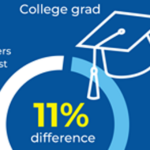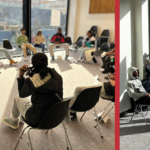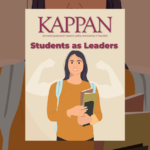In this week’s newsletter: Academic recovery efforts like reading reforms and increased class time are not yet proving to be helping all that much — or are failing to get off the launch pad. Two great stories highlight how housing insecurity and community violence affect students’ lives. Reporters reflect on how they use Twitter. A must-see new education documentary from PBS. And did you spot the hidden education angle in the finale of season two of the White Lotus?
REALITY CHECK
The big story of the week, according to us
Despite all the energy and funding dedicated to improving student learning this year, many states, districts, and schools are struggling to make changes in how to teach and catch kids up. Setbacks and implementation problems are the big story of the week:
🔊 2 cities pursued more school for kids. Only 1 pulled it off. (AP)
🔊 Third graders struggling the most to recover in reading after the pandemic (Hechinger Report)
🔊 Learning Loss Interventions Are Falling Short on Implementation, Study Finds (EdWeek)
🔊 ‘You Don’t Get That Time Back’: Parents Seek Special Ed Services Lost to COVID (The 74)
🔊 Schools Are Spending Big Bucks on Online Tutoring. Here’s What They’ve Learned (EdWeek)
🔊 Bipartisan dyslexia reforms fail again in Michigan Legislature (Chalkbeat Detroit)
🔊 Minnesota tried to recruit teachers of color — and they hired 6 (Star Tribune)
🔊 CPS spent $308 million on school technology since 2020. Now what? (WBEZ Chicago/Chalkbeat Chicago)
🔊 JCPS is going to revisit its reading instruction — but internal discord threatens change (Courier Journal)
🔊 Students turn to TikTok to fill gaps in school lessons (AP)
Other big stories this week: A special grand jury indicted the former superintendent of Loudoun County Public Schools — and a district spokesperson; three trials will be held next year. The Biden administration dissolved a new national parent council less than six months after it was created due to conservative pushback. The 10-year anniversary of the Sandy Hook school shooting occasioned numerous stories of school shooting survivors, security upgrades, and how America’s schools have changed since then.
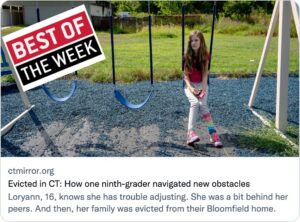
HOUSING & VIOLENCE
The best education journalism of the week, according to us
🏆 BEST: The best story of the week is Evicted: How one ninth-grader navigated new obstacles by the Connecticut Mirror’s Ginny Monk. The story describes how, after having spent time preparing for her first year of high school, student Loryann Pisani found out that her family was evicted and she would be going to another school. “I get very emotional when things are scary,” said Loryann, who is developmentally and intellectually delayed and has an IEP. Housing instability is linked to lower test scores and chronic absenteeism, not to mention the mental health challenges that the disruption can provoke. This story is the second part in a series on eviction and the impact on children. Though not strictly focused on education, this story nonetheless is an example of how reporters can — and should — report on factors outside school. In addition, Monk also gives us abundant insights from the student’s perspective, rather than relying on adult views and descriptions. Everyone should give it a read.
🏆 RUNNER-UP: This week’s runner-up is The Safest Place: At school, he found security. Outside, violence found him, by The Oregonian’s Noelle Crombie. The moving story is about the events leading up to the shooting death of 18-year-old Dante McFallo, a teen who once traveled to the White House to receive an award for a film he made about the juvenile justice system he would later experience firsthand. What’s unique about this story is how Crombie places Dante’s alternative high school at the center of the narrative, both in terms of services and support it provided him and how the school community responds after his death. “I couldn’t even bring myself to go to school because everything just reminded me of Dante,” says one friend. While community violence is often reported on a different beat, it has become increasingly clear that it is also an education issue as more and more young people become victims. This story is also part of a four-part series publishing all this week.
See also: The Lives They Lived in the New York Times
BONUS:
🏆 The City That Kicked Cops Out of Schools and Tried Restorative Practices Instead (In These Times)
🏆 Black male teachers can make a big difference in the lives of their students — why are they so rare? (Boston Globe)
🏆 A Fifth of American Adults Struggle to Read. Why Are We Failing to Teach Them? (ProPublica)
🏆 Thousands of Teens Are Being Pushed Into Military’s Junior R.O.T.C. (New York Times)

STICKING WITH TWITTER — FOR NOW
New from The Grade
For the past several months, Twitter has been embroiled in controversy and concerns about its long-term survival. So we asked a handful of education reporters what they were thinking and found that while many education reporters have deep ambivalence towards the site and have ratcheted back their engagement, most are staying for now. Of course, that could change at any moment. And at least one reporter — the New York Times’ Eliza Shapiro — declared on her Twitter page that she is “not really on here anymore!”
Update: It’s been a month since APM Reports’ Sold a Story wrapped up, and yet there’s been precious little reported news about the surging effort to revamp literacy instruction in schools, districts, and states. What’s going on, people? Efforts to revamp reading instruction are everywhere. Here’s some advice from fellow education reporters on how to approach this year’s biggest story.
Also: Thanks to the Solutions Journalism Network for naming Solutions stories that aren’t puff pieces as one of their favorite pieces of 2022 and to 50CAN for naming our roundup of reporters’ reflections on two years of pandemic schools coverage as among their top 10 resources of the year. Speaking of favorites, one of our most memorable education stories of the year, The Trojan Horse Affair, is also featured in Esquire’s best of 2022 list.
Follow me at @alexanderrusso for thought-provoking commentary all day, every day.
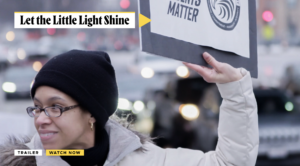
PEOPLE, EVENTS, & NEW RESOURCES
Who, what, when, & where
🔥 A veteran reporter’s departure. (Two, actually.)
⏰ A moving schools documentary now streaming on PBS (above).
🚨 Immediate impact from tough reporting on private schools in Washington State.
🌐 A relatively new Denver education news site you might not yet have heard of.
These are among this week’s big job moves, notable events, and new resources.
Check them all out and then let us know what you think of this effort to streamline the newsletter. We want to know!
TRANSPARENCY IN ST. PAUL
Promising innovations & signs of progress
💡 The “innovation office” at St. Paul (Minnesota) Public Schools is publishing a useful dashboard that shows which of the district’s pandemic-recovery initiatives are succeeding, and which need adjusting. (The 74) Why aren’t other districts providing this kind of information?
💡 Eschewing suspensions, some schools in Arizona have come up with more humane, creative ways to address the problem of student absences. (Hechinger Report/Arizona Center for Investigative Reporting; see last week’s story also)
💡 School districts and local communities are revising the early-pandemic “learning pod” concept to meet the needs of at-risk students. (Hechinger Report/Christian Science Monitor)
💡 A program that brings new classes to NYC high schools that don’t have their own staff to teach them is catching on across the city. (Chalkbeat New York)
💡 A high school math teacher in Denver focuses on acceleration rather than remediation to help freshmen recover from learning loss. (Colorado Public Radio; see also these other programs serving specific student populations)
Read more about the importance of covering promising innovations and preliminary successes.
THE KICKER
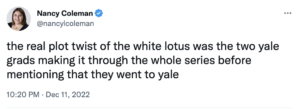
No spoilers here, just truth.
That’s all, folks. Thanks for reading!
Reply to this email to send us questions, comments or tips. Know someone else who should be reading Best of the Week? Send them this link to sign up.
Using Feedly or FlipBoard or any other kind of news reader? You can subscribe to The Grade’s “feed” by plugging in this web address: http://www.kappanonline.org/category/the-grade/feed/.
Read more about The Grade here. You can read all the back issues of The Grade’s newsletter, Best of the Week, here.
By Alexander Russo with additional writing from Colleen Connolly.
ABOUT THE AUTHOR

The Grade
Launched in 2015, The Grade is a journalist-run effort to encourage high-quality coverage of K-12 education issues.









